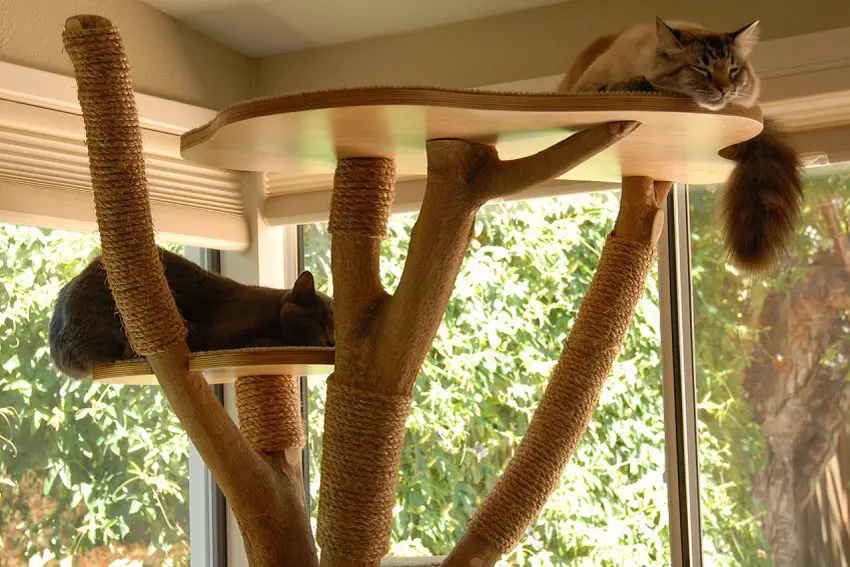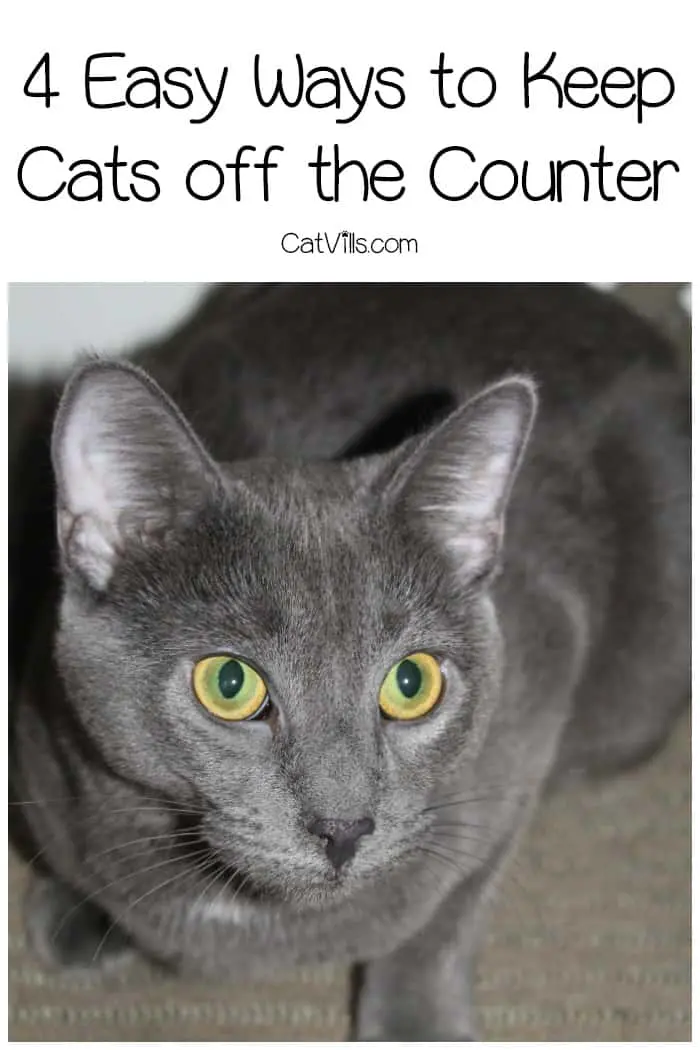Last Updated: 4 months ago
Keeping cats off the counter is something that many cat owners battle with on a regular basis.
While some owners couldn’t care less where their cats go, other owners aren’t keen on the idea of paws that have been in the litter box getting all over the counter.
It can be difficult to keep those kitties off the counter.
Cats are highly mobile, highly independent, and highly uncaring of what we want, generally.
Keeping cats off the counter isn’t a lost cause, though! Read on for some tips on how to make it happen!
#1 Deterrents for Keeping Cats off the Counter

As I mentioned in another post, training is all about consistency. You’ll need to find ways to keep the cat off the counter even when you’re not around.
The following deterrents can help keep your cat off the counter without the need for you to be there on constant guard duty.
Motion Activated Deterrents
There are several motion activated deterrents on the market. Some use citronella spray, and some use compressed air. I’m a fan of the compressed air variety. Another good choice is SSSCAT, which uses a safe, odorless, non-toxic spray.
For one thing, I think citronella is stinky. For another, even though it’s natural, there’s always the possibility that citronella could get in your cat’s eye, nose, or mouth.
Get a motion-activated deterrent that uses compressed air. Simply set the battery-operated device or devices on the counters where your cat normally jumps up.
The compressed air burst will startle the cat. Deterrents that use gentle vibration are also a good option.
Double Sided Sticky Tape
An oldie but a goodie, double sided sticky tape can be an effective tool for keeping cats off the counter. Cats are tactile creatures, and they HATE the feel of sticky tape on their paws.
Simply put the tape on the edges of the counters, and when the cat jumps up and makes contact, “EWW! GET IT OFF ME!”
The downside to this is that depending on how stubborn your cat is, you might have to change out the tape a few times a day. It can also leave a residue on your counters, so be prepared for post-training cleanup.
Aluminum Foil
Like double sided tape, cats hate the feel of aluminum foil. It is a surface that they can’t get a good grip on, so they don’t like to be on it.
Simply line the edges of your counters with aluminum foil. All it takes is a little scotch tape to secure it. The cats hate it, and it’s easier to clean up than double sided tape.
Citrus Fruit Peels
Citrus fruit peels can be used for keeping cats off the counter. Like citronella, citrus fruit peels are not a favorite of cats. The downside to this is that in a few hours, the peels dry up, and the effectiveness is lost.
To extend the life of the peels, you can add a few drops of water to the peels to rehydrate them, but be aware that the effectiveness will not be as potent.
#2 Offer an Alternative

So we’ve covered deterrents, but what if our cat just stayed off the counters altogether?
You can make it happen. Your cat gets on the counter to see what’s happening.
Consider putting a chair nearby that’s designated for the cat. A cat tree would be another good option if you have a big kitchen.
Every time your cat jumps on the counter, move her to the chair or tree. Over time, she’ll figure out that that is HER spot.
#3 Make it Less Fun

Cats are inquisitive creatures, so remove anything interesting from the counters.
- Don’t leave food out.
- Wash your dishes immediately after you eat.
- Always be sure the faucet isn’t dripping – some cats love to drink water from the faucet.
In addition, NEVER pet your cat when she jumps up onto the counter.
Some owners want their cats to stay off the counters, but then they turn around and pet their cat when they jump up there. That only reinforces the problem.
#4 Give Them More Attention

Another reason that cats get on the counter is to be with their people.
If your cat is always jumping up onto the counter for petting, consider giving your cat more time before going into the kitchen.
A solid 10 minutes of petting and snuggling could be just the thing to keep the kitty off your counters.
Keeping Cats off the Counter is Doable
You might think that keeping cats off the counter is a lost cause, but don’t despair. You can do it.
By using a combination of deterrents, an alternate area, and some extra attention before going into the kitchen, you can make keeping cats off the counter a reality.
Give these tips a try, and you’ll most likely see some great results.
Have you already found the perfect solution for how to keep cats off the counter? Share your tips and experiences below!
Resources:


